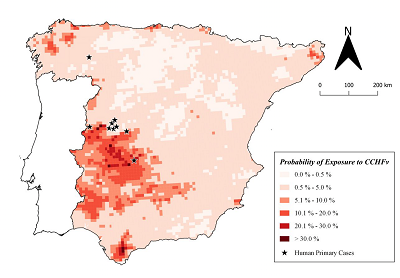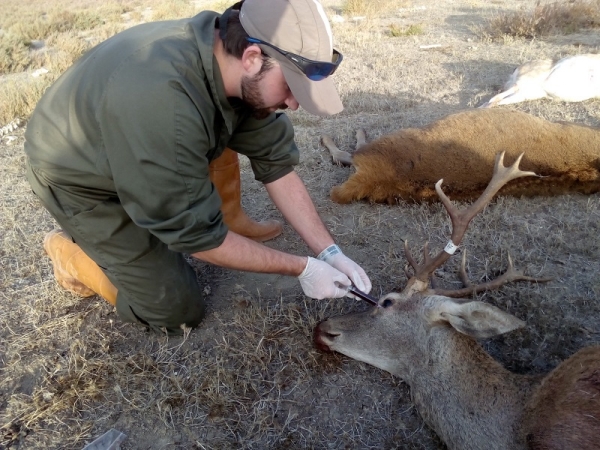The Crimean-Congo hemorrhagic fever (CCHF) virus is transmitted by ticks and is considered by the World Health Organization (WHO) one of the most important emerging infectious diseases. Although not all infected people present symptoms, the pathogen is highly lethal among those who contract the disease. In fact, since the first human case was diagnosed in Spain in 2016, a dozen of them have been reported, with three resulting in death.
Despite the fact that the virus has been detected in various areas of the Peninsula, there had been no complete information about the pathogen's circulation in our country. Now, a research study featuring participation by the University of Córdoba (UCO), together with different national and international groups, has developed for the first time, and at a national level, a map showing the risk of exposure to the virus, which could help health authorities to establish prevention measures in those areas where the probability of the virus's circulation is greater.
"This is the first work at the national level establishing a risk map of this type," explained Ignacio García-Bocanegra, a professor of Animal Health and one of the researchers with the GISAZ group (http://gisaz.org/) at the University of Córdoba that has participated in the study. To do this, the research team analyzed the presence of virus antibodies in more than 1,500 deer from 82 populations distributed throughout Spain. Not surprisingly, these wild ungulates are suitable indicators to determine the circulation of the virus in the natural environment. It is a widely distributed species in Spain and one of the main hosts of the tick that transmits Crimean-Congo hemorrhagic fever. When infected, these ruminants do not show symptoms, but they do produce antibodies that, when analyzed, offer very valuable information on the microorganism's circulation.
According to the results of the study, 50 of the 82 deer populations analyzed had antibodies and, in some of them, more than half of the cervids had been in contact with the pathogen, explains García-Bocanegra. All this data has been the basis on which a predictive epidemiological model has been developed that assesses the risk of infection by areas, taking into account ecological determinants related to the hosts (presence and abundance of domestic and wild ruminants) and environmental vectors (presence and tick distribution) and factors (temperature, precipitation, altitude and humidity, among others).

Hot spots
The study has made it possible to ascertain the areas of greatest risk of exposure to the virus, identifying hot spots; that is, places where most of the tick bites that have led to cases of disease in humans have occurred. Some rural areas in the provinces of Cádiz, Salamanca, Cáceres and Badajoz, and certain places in Galicia and Catalonia, are the main locations where there is the greatest risk of exposure. As such, they are places on which health authorities may focus in the future to prevent and control a virus for which currently there is no vaccine.
In addition to the University of Córdoba, the research work featured participation by the Research Group in Health and Biotechnology (SaBio) of the Research Institute in Game Resources (IREC - CSIC, UCLM, JCCM), the National Center for Microbiology at the Carlos III Institute of Health, the University of Oporto, the Friedrich-Loeffler-Institut (Germany), and the Ministry of Agriculture, Livestock, Fisheries and Sustainable Development's Program for the Epidemiological Surveillance of Wild Fauna (Junta de Andalucía).
References
Cuadrado‐Matías, Raúl & Cardoso, Beatriz &Sas, Miriam & García-Bocanegra, Ignacio &Schuster, Isolde& González-Barrio, David &Reiche, Sven&Mertens, Marc & Cano-Terriza, David & Martí, Laia & Jiménez-Ruiz, Saúl &Martinez-Guijosa, Jordi & Fierro, Yolanda & Gómez-Guillamón, Félix &Gortázar, Christian & Acevedo, Pelayo &Groschup, Martin & Ruiz-Fons, Francisco. (2021). Red deer reveal spatial risks of Crimean ‐ Congo haemorrhagic fever virus infection. Transboundary and Emerging Diseases. 10.1111/tbed.14385.


